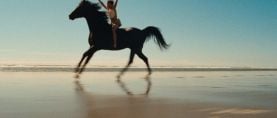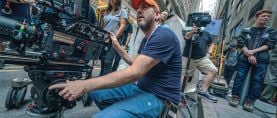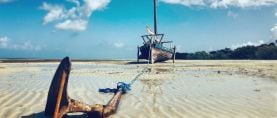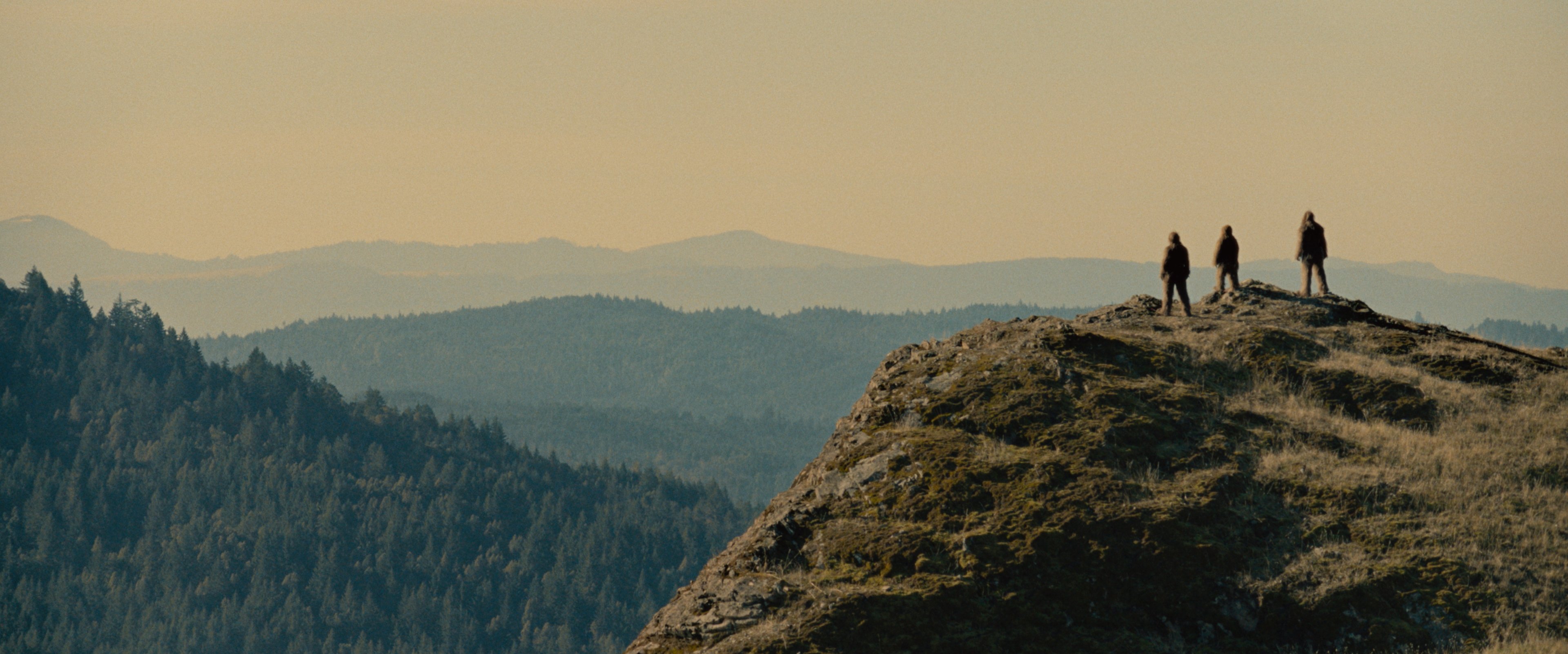
Independent Visions — Four Features to Watch
Recent releases that premiered at this year’s Sundance Film Festival embody the event’s adventurous programming.
Of the projects seen by the AC staff at this year’s Sundance Film Festival, four stood out for their creative use of cinematography to tell unique and often challenging stories. Now that they are all in wide release, it was time to catch up with the filmmakers involved.
I Saw the TV Glow
Cinematographer: Eric Yue
Director: Jane Schoenbrun
I Saw the TV Glow takes an elastic view of reality. The film’s compositions are bathed in darkened neon colors and deep shadows, with long, steady tracking shots, and faces appearing lit by the glowing flicker of television screens. The line between the real world and delusion is positioned to be questioned by the audience — and by the characters themselves as the cohesion of their world unravels. Both pulling that thread and threading the needle is trippy recurring imagery from a ’90s supernatural kids show that morphs with the sway of time and memory.
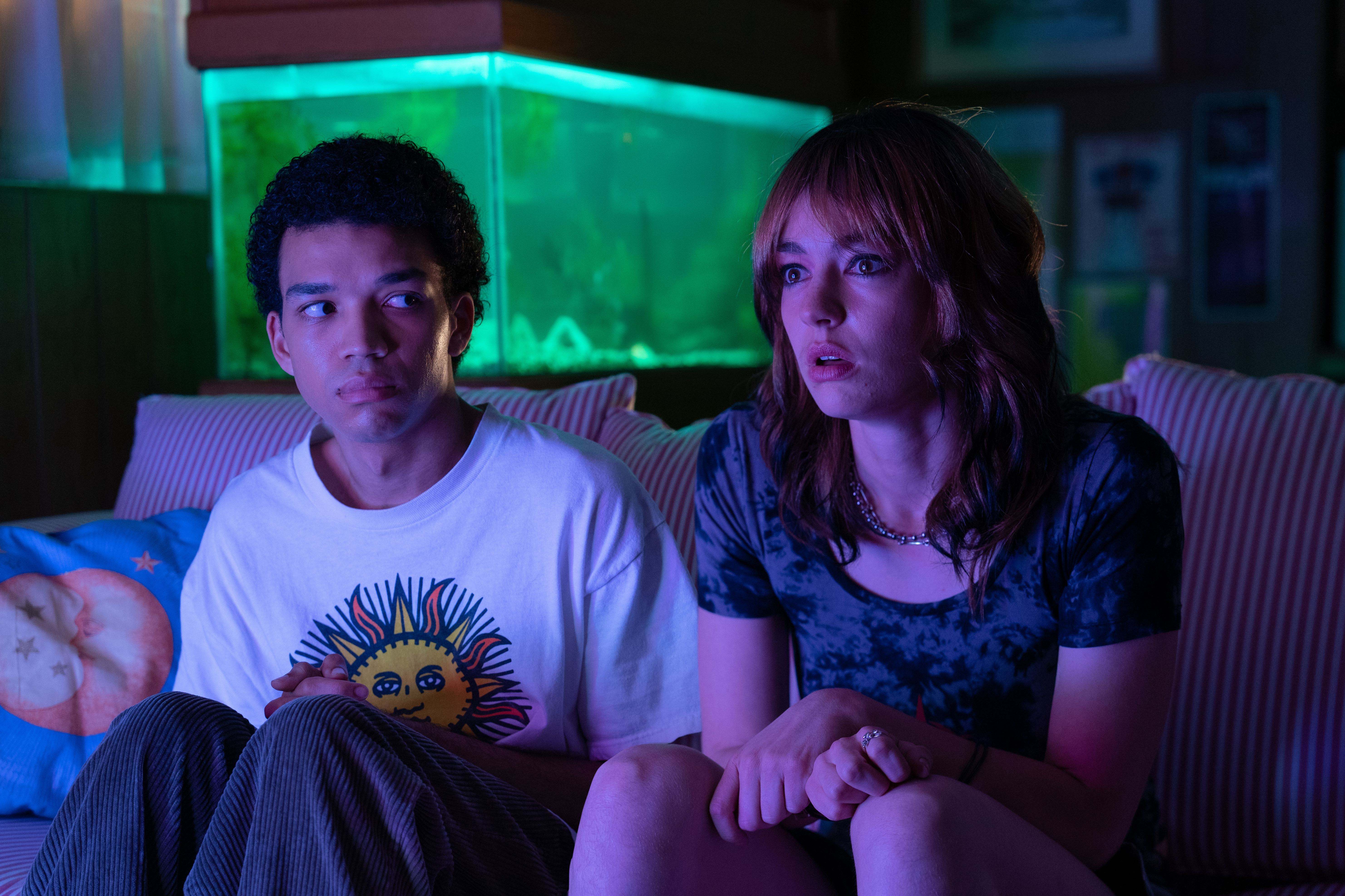
The film begins with seventh grader Owen (played by Ian Foreman in the character’s younger years and by Justice Smith later on), who’s already a committed loner, as he meets ninth grader Maddy (Brigette Lundy-Paine), who’s reading an episode guide for a TV show called The Pink Opaque. He wants to know about it. She ponders for a moment, then deems him worthy. He joins her in all-consuming fandom — with the show as the focal point of their lives, defining their identities.
Cinematographer Eric Yue and writer-director Jane Schoenbrun shot I Saw the TV Glow on 35mm, “because 35mm is beautiful, and there was no other format that was going to bring out the textures and make every shot feel holy and gorgeous in the way that 35 does,” says Schoenbrun in the press notes for the feature. “I think I need to, as an artist, believe that the images I'm capturing are holy or poetic or imbued with romance. And since I tend to make movies about media, I want to integrate the mediums and actual formats into the creative process.”
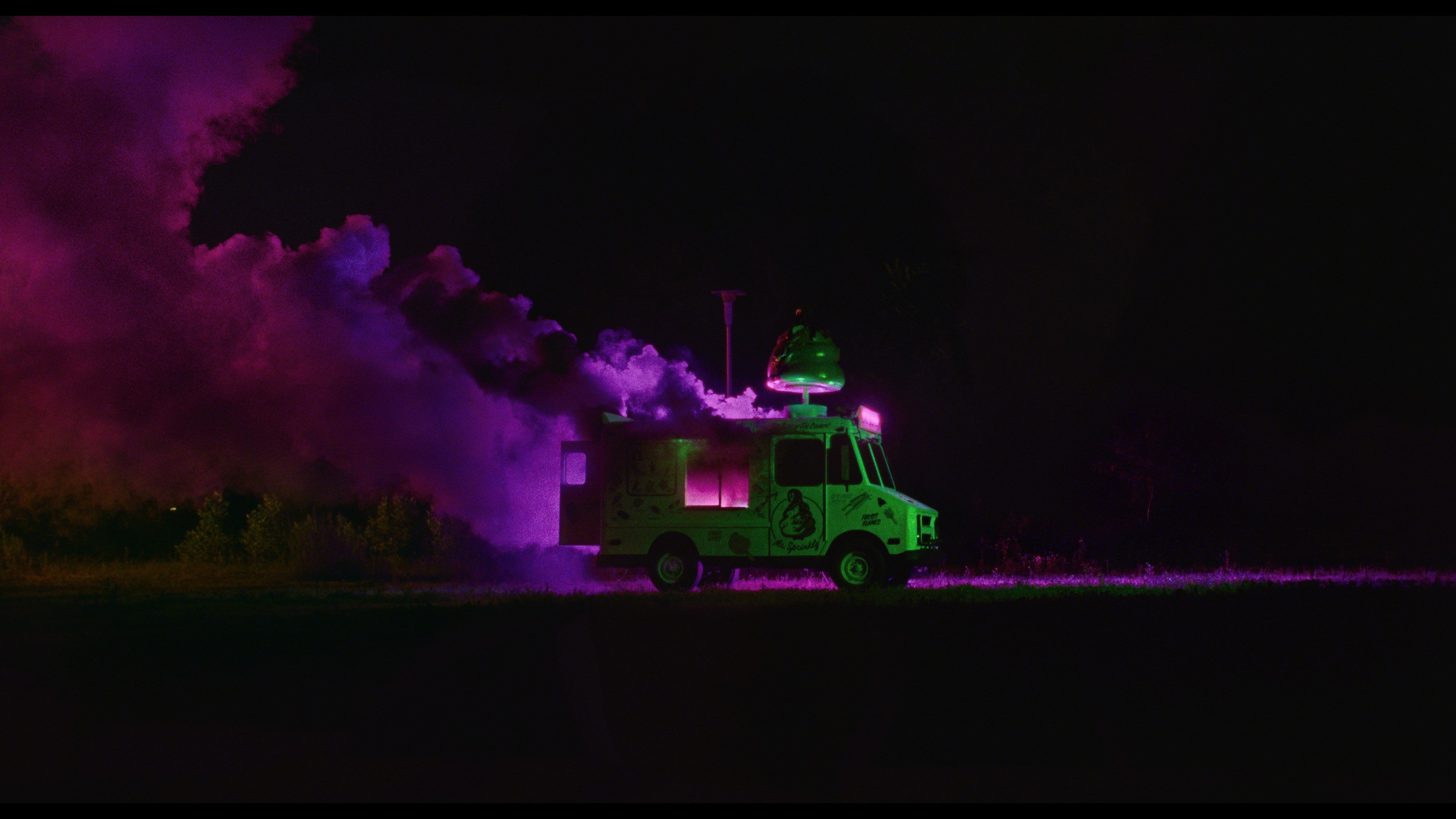
Adds Yue, “I wanted [the film] to feel like you ate so much cotton candy that you’re going to vomit because it was so sweet and then it’s too sweet all of a sudden. We’re pushing the colors to the point where it’s almost unnaturally saturated with color. And then there are these moments where it’s sort of ‘classically beautiful’ and transcendent in a certain way. They’re not sickening moments — they’re really about bliss or discovery.”
During an ASC panel at Canon Creative Studio at Sundance, Yue noted that an early reference for the film was Krzysztof Kieślowski’s Three Colours: Blue, with its “unnatural” permeation of the color blue. For I Saw the TV Glow, the filmmakers wanted colors that similarly “relate to the characters’ internal world and what they're going through,” the cinematographer said. He pointed to the use of a fish tank that glowed a saturated neon green, which served as a prominent piece of the set design in the room where Maddy and Owen watched their show — in particular for a dreamlike, intimate-yet-platonic moment between the two. The sequence was “shot in this very sensual way,” Yue said. “It was like a sex scene, but not.”
Yue explained that the team experimented “with different colors [from our] pallet from the camera tests we’d developed, and green became this emotional thing that worked. We all looked at it [and thought] it could be blue — like teal — like a normal fish tank, but that felt a little bit more cold; it didn't feel romantic … But the green just kind of worked. And pink was a big color as well — that was The Pink Opaque color. Since green is complementary to pink, it makes sense that the two work together in harmony.”

For The Pink Opaque TV footage that punctuates the kaleidoscopic narrative, the filmmakers ultimately landed on a worn-down, copy-of-a-copy look. “The original idea was that the ’90s show would not look any different [from the rest of the film], so we shot all of that on 35,” Yue said. “But in the end [we decided], ‘Let’s transfer the 35 to VHS.’ So, that was [something] we found afterwards that helped translate and tell the story, and make this world more legible. We would do the VHS transfer, and sometimes it would lose too much information in the wide shot. So, we would do one version where we’d transfer to VHS, and we'd also do an HDCam version — which is a step up from VHS — and then we’d have a plugin that's more controlled. Then you can layer them.” Yue offered a “shout out” to colorist Mikey Rossiter and the VFX team for tasks such as “dealing with the layers of a wide shot where you're isolating a part [of it] — like, ‘Let’s see more detail there.’ And you'd dial down the opacity of the VHS to blend it with the HDCam, because you want to see a little bit more of the eye.”
Beyond the borders of this specific film, Yue had some insightful thoughts about the position of the cinematographer within the geometry of a production. He recalled, “On a movie I did, I was having a conversation about what is ‘below the line’ and what is ‘above the line’ — and my gaffer was like, ‘You are the line.’ And I think about that constantly. You're the point person between the director, the producer and the crew … You're having to constantly navigate all these things. ‘The line’ is a very existential place to exist.”
— Andrew Fish
I Saw the TV Glow opened theatrically nationwide on May 17.
Stress Positions
Cinematographer: Arlene Muller
Director: Theda Hammel
Underscored by swift, inquisitive moves and peppered with in-shot zooms and uncomfortably tight close-ups, cinematographer Arlene Muller’s oft-handheld camerawork on Stress Positions seemed intent on drilling into the characters’ angst, struggles and strong opinions. It was a very small film crew that gathered in Brooklyn, N.Y., to tell this madcap 2020 lockdown tale of unemployed, high-strung Terry Goon (John Early), who works frantically to accomplish very little for his injured nephew, Bahlul (Qaher Harhash), as he convalesces in Terry’s spare bedroom. From the leadup to Terry’s July Fourth barbecue through its aftermath, chaos and claustrophobia permeates as he frenetically navigates his new responsibility; his grief over the recent breakup of his marriage to Leo (John Roberts); his combative relationship with his friend Karla (Theda Hammel, who also wrote and directed); and his sheer terror of contracting the coronavirus.

While speaking at an ASC panel at Canon Creative Studio at Sundance, Muller explained that the onscreen pandemonium didn’t mirror the actual filmmaking experience. “A lot of the shots were planned to be longer, and I think a lot of the chaotic, frenetic, ‘Safdie’ feel was found in the editing,” she said. “So, it wasn’t like [it appears in the film] the whole time.” She noted that the actual challenges included a minimal crew, small budget and tight schedule — the hallmarks of indie filmmaking.
Shooting 2K with vintage Canon 16mm zooms, the cinematographer added, was a big help in saving time. “[The lenses] gave us a lot of flexibility,” she said. “That’s how we made our days — I was on a handheld camera with the zoom!” And, in concert with the Arri Alexa 35, the lenses yielded colors and textures that made the image “feel more ‘filmy,” she said, which reflected the kind of look the director was after. “Theda talked about how she wanted an honesty and a truth to the shots, but she didn’t want it to feel overly digital. She didn’t want it to be precious, and at the same time she wanted it to feel honest and real, and she also said she didn’t want to sacrifice beauty. I own a Canon 16mm-zoom package, so I was bringing on some of my own lenses, like the 7-63mm. And Theda — who’s actually a gearhead — bought an 11-165mm, and that became one of our most-used lenses on the shoot; it’s so versatile.”
When asked about a scene in which an unconscious Leo is hauled through the house while old photos from his and Terry’s joyful wedding are projected onto the hectic endeavor, Muller explained that the setup was in line with an overarching motif. “We talked a lot with Theda about creating obstacles and barriers in the film. The film is a satire about the difficulty of connection between these millennial characters, and it’s a Covid movie, so we were shooting through barriers. There are plastic barriers and sometimes the characters are wearing masks — and taking them off and putting them on and getting sick of them … and the lighting was part of that as well. In those scenes, we’re trying to create layers. [For the sequence where Leo is carried off], it’s this chaotic scene, and that chaos is underscored by the fact that there’s a projected image over the characters as these things are happening. [At some points, we were shooting] directly into the projector. [There was a shot in which] one of the main characters watches a scene on the projector, and he moves his head and the projector light just floods the camera. It creates tension, angst, anxiety, and I think that’s what Theda was going for with some of that.”
Muller praises gaffer Sean Gradwell, who “was absolutely not afraid to use harder light. We were bouncing off the floor, and sometimes shining lights directly into the scenes with very little diffusion. That was one of the first times I worked with somebody who was so fearless about harder light, and it was amazing.”
Muller adds that her work on this low-budget production with a first-time feature director gave her new insight into the importance of setting up avenues rather than restrictions. “A lot of times as director of photography, you have to face these situations where you might need to put limits … One of the things that I really took away from this production is saying ‘yes’ to more things and then going with it. And taking that leap of faith, rather than immediately saying … ‘That’s technically impossible’ — and instead saying, ‘Let’s work together to find a way to do what you want to do.”
Location was also a key element in keeping the budget and schedule on track. With a few exceptions that required some additional grip and electric crew, the settings were limited to the vicinity of the one house. “Our director was very smart,” the cinematographer says. “She wrote the movie for a single location — and in and around that location. We had a car scene, we had a couple night exteriors on the street and we had another apartment that we were shooting in, but for the most part, we were almost 18 or 20 days in the same location.”
The dual catches with a single shooting locale were keeping shots looking fresh and maintaining enthusiasm behind the scenes. “You do get fatigue,” Muller says. “You’re in the same room for days and it definitely gets hard, but one thing that helped was Theda’s willingness to experiment with different [framing choices]. She would say, ‘Let’s put the camera really high, let’s suddenly get low, let’s go tight, let’s only cover this with a really wide shot and then some close ups.’ I think all of that was fun and exciting for her. And it also goes back to me being able to say ‘yes’ to that … It was a great experience for me to be able to feel free like that.”
— Andrew Fish
Stress Positions opened theatrically on April 19 and is now available to stream on YouTube, Google Play, Apple TV, Fandango at Home and Amazon Prime Video.
Sasquatch Sunset
Cinematographer: Mike Gioulakis, ASC
Directors:
David Zellner and Nathan Zellner
Anyone with an interest in cryptids — especially fans of Bigfoot — will be intrigued by this unusual Sundance offering, which follows a group of Sasquatch creatures through their daily strides as they lead a stealthy existence in a forest, where they forage for food, watch each other’s backs (literally, by picking and grooming their compatriots’ fur), and endure the occasional “interfamilial” squabbles.
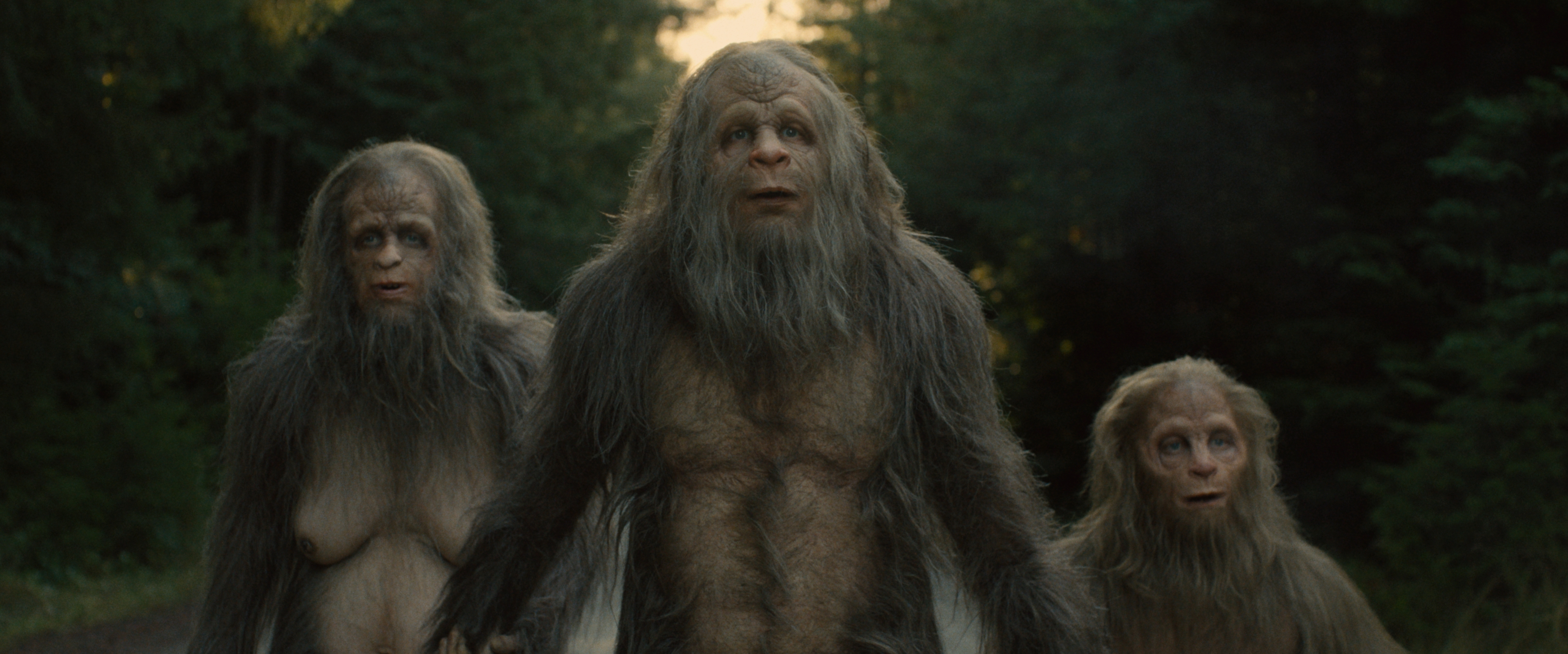
The movie (which opened theatrically in mid-April) proved to be a love-it-or-not entry at this year’s festival, where audience members were either laughing and applauding at the many gross-out moments unfolding onscreen, or groaning in disgust. A few less intrepid viewers even walked out the door, but those who did missed the film’s most touching and heartrending moments as the Sasquatches experience both joys and tragedies over the course of a year.
Writer-directors David and Nathan Zellner took a big risk with their dialogue- and narration-free approach to the story (the creatures communicate exclusively through grunts and other sounds that the audience is left to interpret) and by casting a pair of prominent actors (Jesse Eisenberg and Riley Keough) who perform anonymously under heavy prosthetics and costumes designed by visual-effects artist Steve Newburn, conveying their Sasquatch emotions primarily through animal sounds, body language and their eyes. The performers — who included Nathan Zellner himself as the group’s alpha male, and Christophe Zajac-Denek as a Sasquatch child — even attended a “Sasquatch camp” to learn how to walk, lounge, sleep and eat as a non-human species might, and also to tailor their approaches for each of their Sasquatch characters.

In a directors’ statement, the Zellners note that they’ve “been interested in Sasquatch/Bigfoot lore since childhood,” adding that “almost every part of the world their own variation on the ‘man of the woods’ myth, all of which fascinatingly emerged independently of one another long ago.”
They added, “Most accounts of Bigfoot sightings revolve around it scurrying away upon discovery, which are all interesting but eventually led us to wonder, what else is it doing? What are its behavior patterns? Not just the noble and majestic characteristics we’ve become accustomed to through folklore, but also the less flattering, often absurd traits that reflect the full spectrum of human and animal behavior. Traits that are entirely relatable, directly and indirectly, whether we like it or not. It’s that uncomfortable relatability that makes way for the inherent comedy, tragedy, and poignancy of these creatures, and what ultimately drew us to make this film.”

A major source of inspiration for the filmmakers was an episode of the 1977-’82 strange-phenomena television series In Search Of… that showcased controversial Bigfoot footage shot in in 1968 by Robert Patterson and Robert “Bob” Gimlin. Known as the Patterson-Gimlin film, the striking footage documents a large, furry, long-armed creature striding through a wooded area in Northern California. As the Sasquatch Sunset press notes explain, “The iconic footage has been subjected to decades of attempts to authenticate or debunk it, and is the foundational text for the contemporary belief surrounding the ape-like forest dweller that roams the Pacific Northwest.” (The Patterson-Gimlin film can be viewed here.)
The filmmakers also took cues from 1970s Disney live-action animal films and animal documentaries, as well as the 1988 French-British feature The Bear, in which an orphaned cub forms a bond with an adult bear. In prepping their film for a 23-day shoot, the Zellners even studied animal behavior and reviewed research by cryptozoologists, anthropologists and the Sasquatch community.
ASC member Mike Gioulakis was tasked with tying all of the production’s complex elements together visually. He opted for an “epic” but also naturalistic approach, noting, “We already have the spectacle of this creature design and the epic landscape, so we didn’t want the cinematography to draw attention to itself.”
Once production began in California’s Humboldt County, Gioulakis used an Arri LF camera with specialized lenses to capture the full height and majesty of the area’s redwood trees. In the movie’s press notes, he explains, “We leaned into a 1970s aesthetic, a softer image with a bit of a patina to it — and a bit of screwball comedy influence. We wanted it to be all about the majesty of nature and of these creatures.”
Gioulakis had to abandon the usual resources and gear he was accustomed to on larger productions, lighting some scenes with just an LED flashlight he’d purchased at Target. But the cinematographer testifies that he found the project both personally and creatively rewarding: “It was hard being out in the elements every day, dragging equipment over fields and gullies, but everyone was pitching in to help, just there for the love of filmmaking. It was just such a wonderful, pure experience.”
— Stephen Pizzello
Sasquatch Sunset opened theatrically on April 12 and is now available to stream on Amazon Prime Video, Apple TV, YouTube, Google Play Movies & TV and Fandango at Home.
Love Lies Bleeding
Cinematographer: Ben Fordesman
Director: Rose Glass
This libidinous Sundance thriller plays matchmaker between a forlorn gym manager, Lou (Kristen Stewart), and an aggressively gung-ho female bodybuilder, Jackie (Katy O’Brian), who stops in New Mexico on her way to a fitness competition in Las Vegas, where she hopes to dominate the field and jump-start her career. Sparks fly shortly after Lou notices Jackie and her sculpted physique during a workout, and the two soon make a more physical connection. Complications ensue, of course, and the star-crossed lovers get caught up in a series of sordid entanglements — involving Lou’s criminally inclined family — that rapidly devolve into ultraviolent mayhem.

A fever dream on steroids, Love Lies Bleeding injects the viewer with shots of sweaty skin, oiled-up muscles, popping veins and the bloody messes that Lou is forced to clean up after the couple’s volcanic affair erupts.
Cinematographer Ben Fordesman crafts a compelling neo-noir ambience for British director Rose Glass, imbuing the offbeat saga with a surreal patina after Lou begins helping Jackie pump up with ample doses of synthetic hormones. As the ’roids kick into overdrive, the filmmakers begin nudging their characters beyond their initially more naturalistic, low-key surroundings and into far trippier realms rendered with woozy camerawork and dreamlike imagery. In the film’s press notes, Glass acknowledges that her work with Fordesman on her debut feature, Saint Maud, informed their approach to Love Lies Bleeding, as the duo “kept building on a similar visual language which dances the lines between grounded reality and heightened theatricality.”
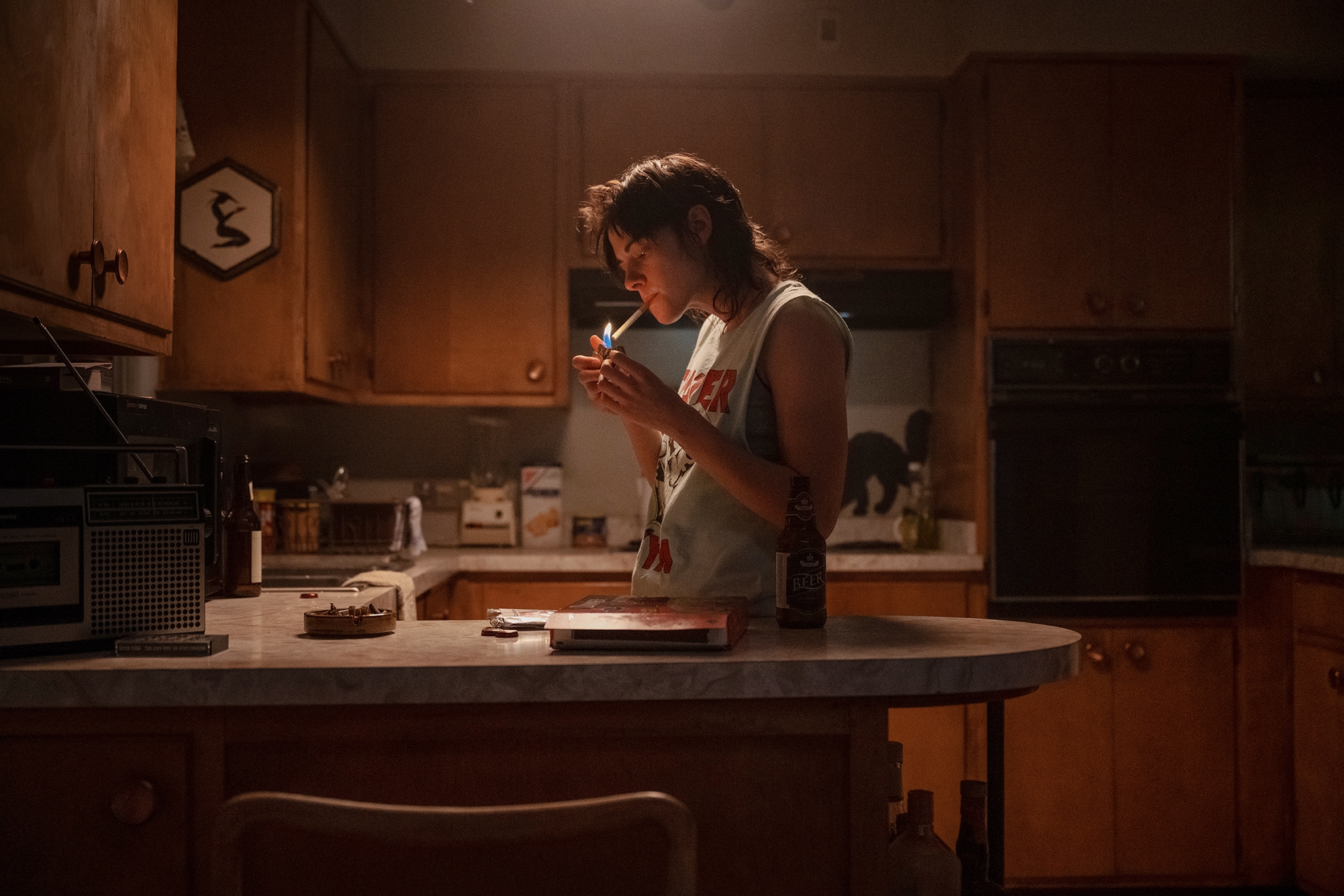
Glass chose to set the film in the 1980s “because it felt like the ultimate decade of excess, poised right on the cusp of the nihilism of the ’90s. It felt like the excess was just reaching a peak before it inevitably fell apart.” She initially thought about shooting the film in Scotland, but ultimately opted for the craggy landscapes of New Mexico, with the desolate gym and a dusty desert gun club as key settings. “With all the muscles and guns, America just made the most sense,” she reasoned. “The melodrama of the story fit nicely in that world. It’s a pretty warped, heightened version of America.”
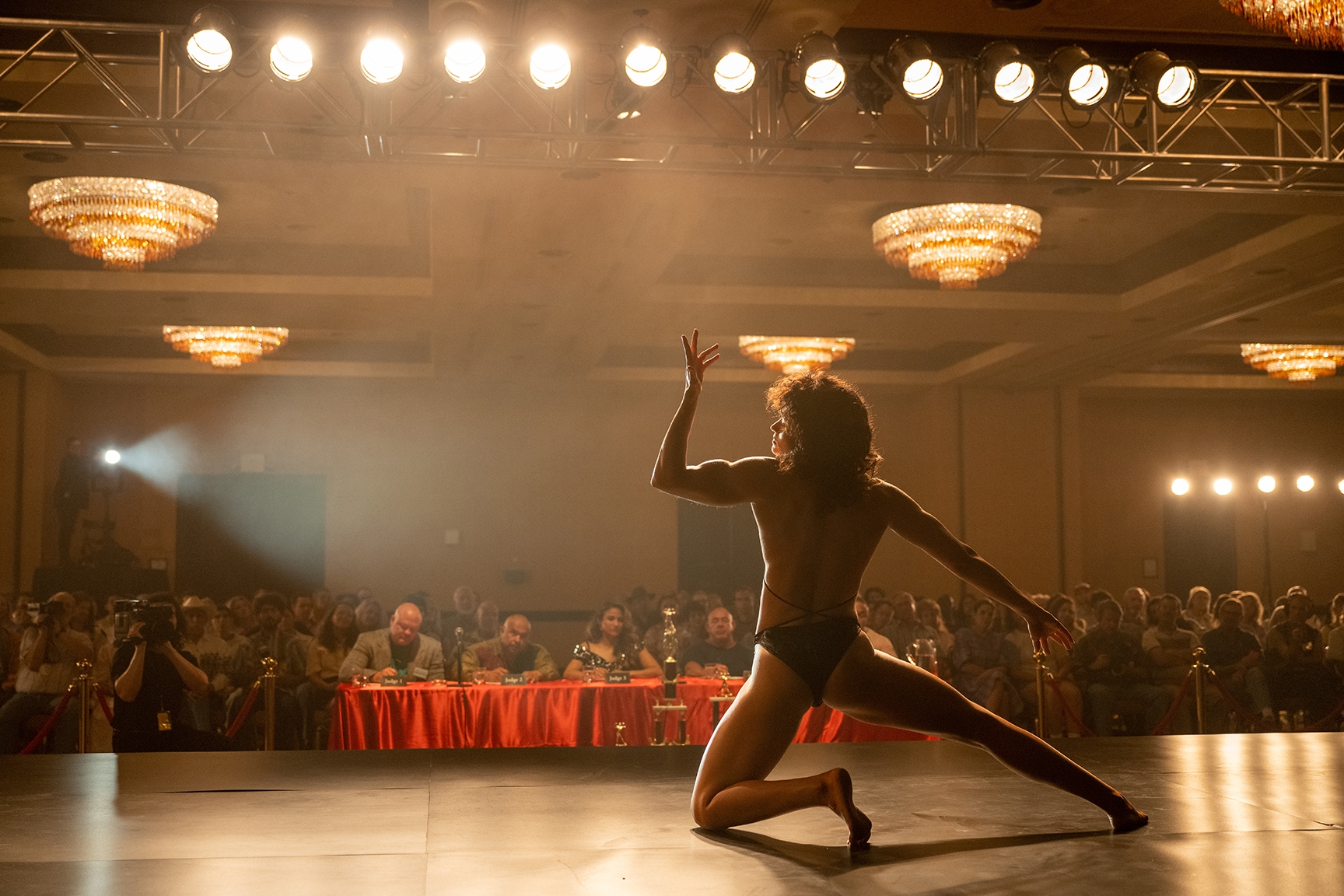
The director’s aesthetic references for the film’s look and tone provided Fordesman with a visual roadmap based on features that included Showgirls, David Cronenberg’s Crash, Snake of June, Barfly and Mystery Train, among others. Fordesman noted, “We wanted a look that was drenched in Americana, and I was personally drawn to cinematographer Robbie Müller’s work with Wim Wenders on Paris, Texas and [with] William Friedkin on To Live and Die in L.A. I love their use of available light — particularly artificial lighting from mercury-vapor streetlights, which produced a bold blue/green hue, a strong look which we had to reproduce with modern LED lighting equipment. This look paired with the last ‘blue hour’ light of the day is magical, and we shot as much as we could in these critical lighting conditions.”
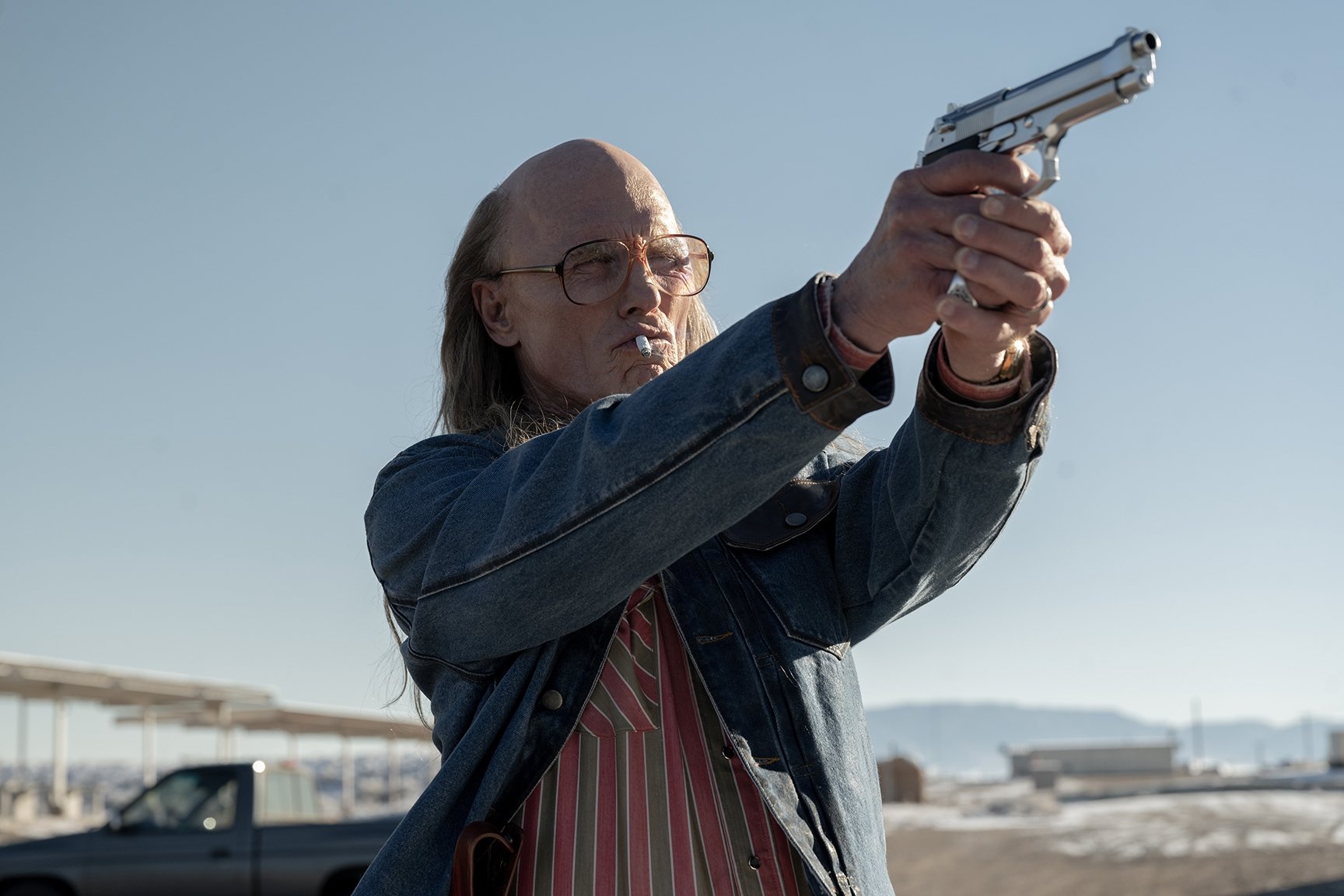
Production designer Katie Hickman also followed these leads, striving to achieve Glass’s desire for a look the director described as “grungy.” In the movie’s press notes, Hickman explains, “I just went fully into that grittiness. A lot of the story takes place at night. But then we also accent the darkness with some lightness and comedy, especially with some of the more quintessential ’80s looks. For example, we used desert peach and sage green in some of the more elevated locations, like Lou Senior’s mansion. We had a lot of really large and detailed sets we could really dig into. But the overriding idea was that every element should be a little weird, a little nostalgic, and very memorable.”
Fordesman found further inspiration at the show’s locations in New Mexico, which triggered his cinematic nostalgia while providing stunning backdrops for the movie’s offbeat story. “I loved the desert, Winkies Diner, the gym, Lou’s apartment — they all felt very familiar from films I have watched in my life, but being there and making a film with an incredible crew was kind of the dream. We experienced a lot of storms and breathtaking skies: There was a certain element of serendipity since we would start the day with regular blue skies and hard brutal sun, and out of nowhere rain and lighting could come and we would have to take cover and shoot the remainder of the scene in the most wonderful lighting conditions. It wasn’t ideal for our schedule or consistency, but sometimes we caught nature at its finest.”
Perhaps the best summation of the movie’s unique qualities comes from actor Jena Malone, who plays Lou’s sister Beth: “Even as a member of the cast, trying to describe this film is a challenge. Is it a queer fantasy? Is it a thriller? Is it a romance? It’s so many different types of things without being like anything you know. There’s this amazing oscillation between camp, comedy, love, and the depravity and complications of human nature.”
— Stephen Pizzello
Love Lies Bleeding opened theatrically on March 8 and is now available to stream on various services, including Amazon Prime Video, Apple TV, YouTube, Google Play Movies & TV and Fandango at Home.
You’ll find full details on AC’s panel events held at Sundance in partnership with the Canon Creative Studio right here, complete with each video program with the participating filmmakers.
